2023 HONDA HRV child restraint
[x] Cancel search: child restraintPage 16 of 664

14
Quick Reference Guide
Safe Driving (P 33)
Airbags (P50)
●Your vehicle is fitted with airbags to help protect you and
your passengers during a moderate-to-severe collision.
Child Safety (P70)
●All children 12 and younger should be seated in the rear seat.●Smaller children should be properly restrained in a forward-facing child seat.●Infants must be properly restrained in a rear-facing child seat.
Exhaust Gas Hazard (P83)
●Your vehicle emits dangerous exhaust gases that contain
carbon monoxide. Do not run the engine in confined spaces
where carbon monoxide gas can accumulate.
Before Driving Checklist (P38)
●Before driving, check that the front seats, head
restraints, steering wheel, and mirrors have been
properly adjusted.
Seat Belts (P39)
●Fasten your seat belt and sit upright well
back in the seat.
●Check that your passengers are wearing
their seat belts correctly.
Fasten your lap belt as
low as possible.
23 HR-V-313V06000_01.book 14 ページ 2022年4月4日 月曜日 午前10時49分
Page 40 of 664

38
uuFor Safe Driving uSafety Checklist
Safe Driving
Safety Checklist
For the safety of you and your passenge rs, make a habit of checking these items
each time before you drive.
• After everyone has entered the vehicle, be sure all doors and the tailgate are
closed and locked. Locking the doors and the tailgate helps prevent an occupant
from being ejected and an outsider from unexpectedly opening a door or the
tailgate.
2 Locking/Unlocking the Doors from the Inside P. 149
•Adjust your seat to a position suitable for driving. Be sure the front seats are
adjusted as far to the rear as possible while allowing the driver to control the
vehicle. Sitting too close to a front airbag can result in serious or fatal injury in a
crash.
2 Seats P. 180
•Adjust head restraints to the proper position. Head restraints are most effective
when the center of the head restraint alig ns with the center of your head. Taller
persons should adjust their head restraint to the highest position.
2 Adjusting the front head restraint positions P. 186
•Always wear your seat belt, and make sure you wear it properly. Confirm that any
passengers are properly belted as well.
2 Fastening a Seat Belt P. 44
•Protect children by using seat belts or child seats according to a child’s age,
height, and weight.
2 Child Safety P. 70
1Safety Checklist
If the door and/or tailga te open message appears on
the driver information inte rface, a door and/or the
tailgate is not completely closed. Close all doors and
the tailgate tightly unti l the message disappears.
23 HR-V-313V06000_01.book 38 ページ 2022年4月4日 月曜日 午前10時49分
Page 58 of 664
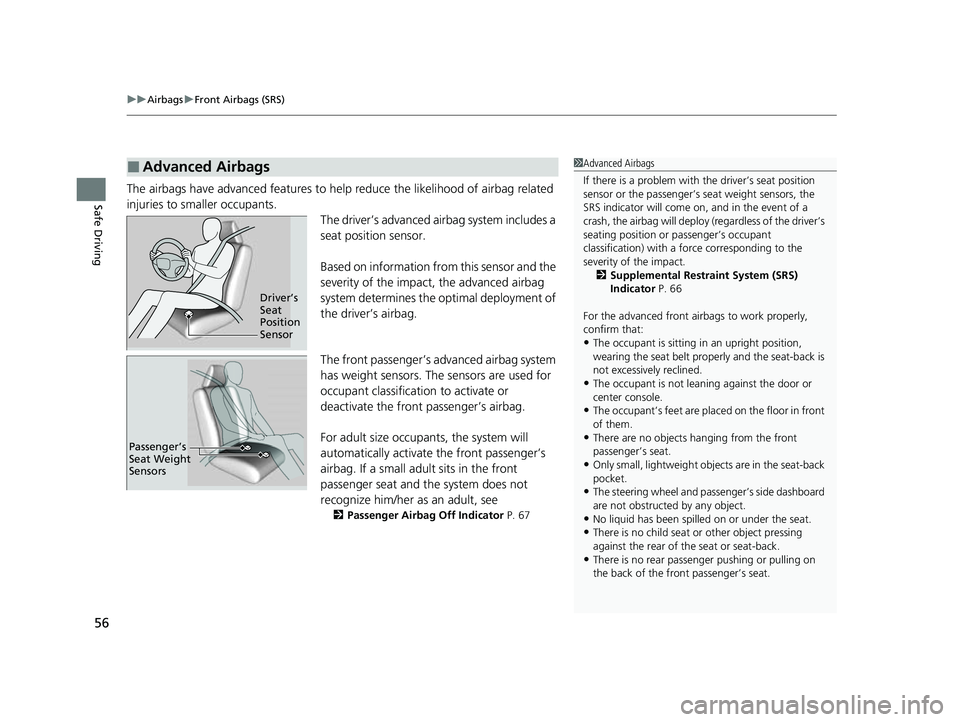
uuAirbags uFront Airbags (SRS)
56
Safe DrivingThe airbags have advanced features to help reduce the likelihood of airbag related
injuries to smaller occupants.
The driver’s advanced airbag system includes a
seat position sensor.
Based on information from this sensor and the
severity of the impact, the advanced airbag
system determines the optimal deployment of
the driver’s airbag.
The front passenger’s advanced airbag system
has weight sensors. The sensors are used for
occupant classification to activate or
deactivate the front passenger’s airbag.
For adult size occupants, the system will
automatically activate the front passenger’s
airbag. If a small adult sits in the front
passenger seat and the system does not
recognize him/her as an adult, see
2Passenger Airbag Off Indicator P. 67
■Advanced Airbags1Advanced Airbags
If there is a problem with the driver’s seat position
sensor or the passenger’s s eat weight sensors, the
SRS indicator will come on, and in the event of a
crash, the airbag will deploy (regardless of the driver’s
seating position or passenger’s occupant
classification) with a force corresponding to the
severity of the impact. 2 Supplemental Restraint System (SRS)
Indicator P. 66
For the advanced front airbags to work properly,
confirm that:
•The occupant is sitting in an upright position,
wearing the seat belt prope rly and the seat-back is
not excessively reclined.
•The occupant is not leaning against the door or
center console.
•The occupant’s feet are plac ed on the floor in front
of them.
•There are no objects ha nging from the front
passenger’s seat.
•Only small, lightweight objects are in the seat-back
pocket.
•The steering wheel and passenger’s side dashboard
are not obstructed by any object.
•No liquid has been spille d on or under the seat.•There is no child seat or other object pressing
against the rear of the seat or seat-back.
•There is no rear passenger pushing or pulling on
the back of the front passenger’s seat.
Driver’s
Seat
Position
Sensor
Passenger’s
Seat Weight
Sensors
23 HR-V-313V06000_01.book 56 ページ 2022年4月4日 月曜日 午前10時49分
Page 59 of 664
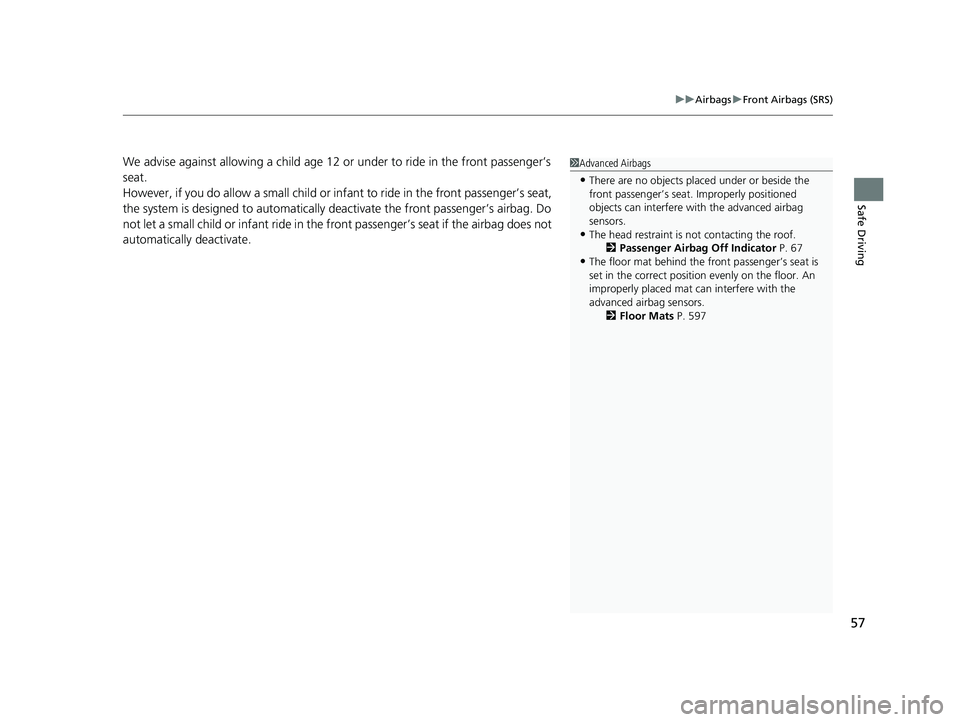
57
uuAirbags uFront Airbags (SRS)
Safe Driving
We advise against allowing a child age 12 or under to ride in the front passenger’s
seat.
However, if you do allow a small child or in fant to ride in the front passenger’s seat,
the system is designed to automatically de activate the front passenger’s airbag. Do
not let a small child or infant ride in the front passenger’s seat if the airbag does not
automatically deactivate.1 Advanced Airbags
•There are no objects placed under or beside the
front passenger’s seat . Improperly positioned
objects can interfere with the advanced airbag
sensors.
•The head restraint is not contacting the roof.
2 Passenger Airbag Off Indicator P. 67
•The floor mat behind the front passenger’s seat is
set in the correct position evenly on the floor. An
improperly placed mat can interfere with the
advanced airbag sensors. 2Floor Mats P. 597
23 HR-V-313V06000_01.book 57 ページ 2022年4月4日 月曜日 午前10時49分
Page 69 of 664
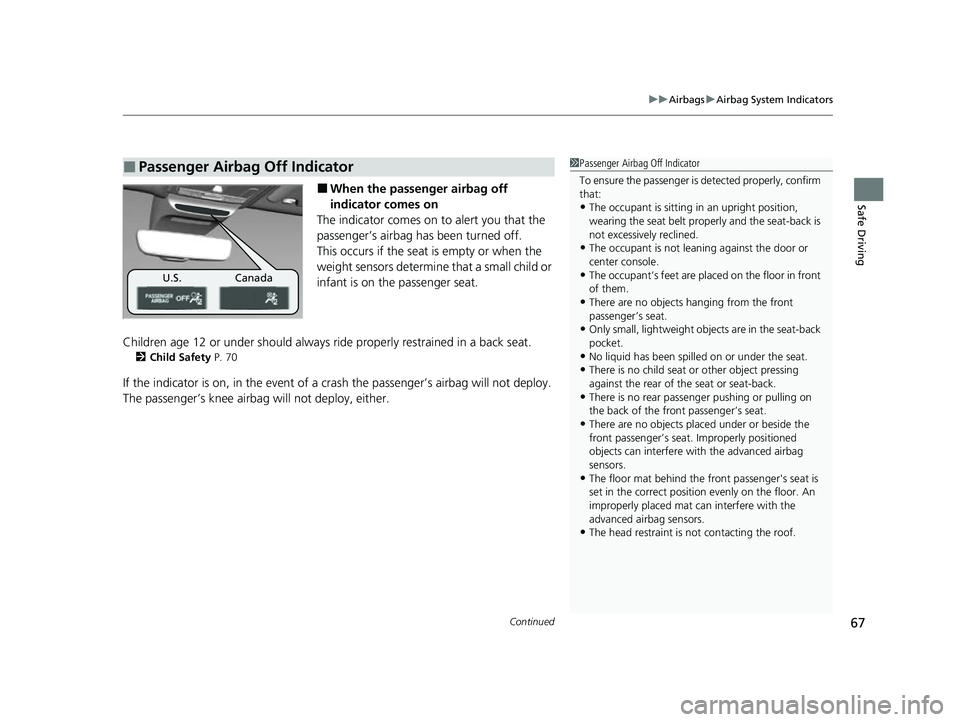
Continued67
uuAirbags uAirbag System Indicators
Safe Driving■When the passenger airbag off
indicator comes on
The indicator comes on to alert you that the
passenger’s airbag has been turned off.
This occurs if the seat is empty or when the
weight sensors determine that a small child or
infant is on the passenger seat.
Children age 12 or under should always ride properly restrained in a back seat.
2 Child Safety P. 70
If the indicator is on, in the event of a cr ash the passenger’s airbag will not deploy.
The passenger’s knee airbag will not deploy, either.
■Passenger Airbag Off Indicator1 Passenger Airbag Off Indicator
To ensure the passenger is detected properly, confirm
that:
•The occupant is sitting in an upright position,
wearing the seat belt prope rly and the seat-back is
not excessively reclined.
•The occupant is not leaning against the door or
center console.
•The occupant’s feet are plac ed on the floor in front
of them.
•There are no objects ha nging from the front
passenger’s seat.
•Only small, lightweight objects are in the seat-back
pocket.
•No liquid has been spille d on or under the seat.
•There is no child seat or other object pressing
against the rear of the seat or seat-back.
•There is no rear passenger pushing or pulling on
the back of the front passenger’s seat.
•There are no objects placed under or beside the
front passenger’s seat . Improperly positioned
objects can interfere with the advanced airbag
sensors.
•The floor mat behind the front passenger's seat is
set in the correct position evenly on the floor. An
improperly placed mat can interfere with the
advanced airbag sensors.
•The head restraint is not contacting the roof.
U.S. Canada
23 HR-V-313V06000_01.book 67 ページ 2022年4月4日 月曜日 午前10時49分
Page 78 of 664
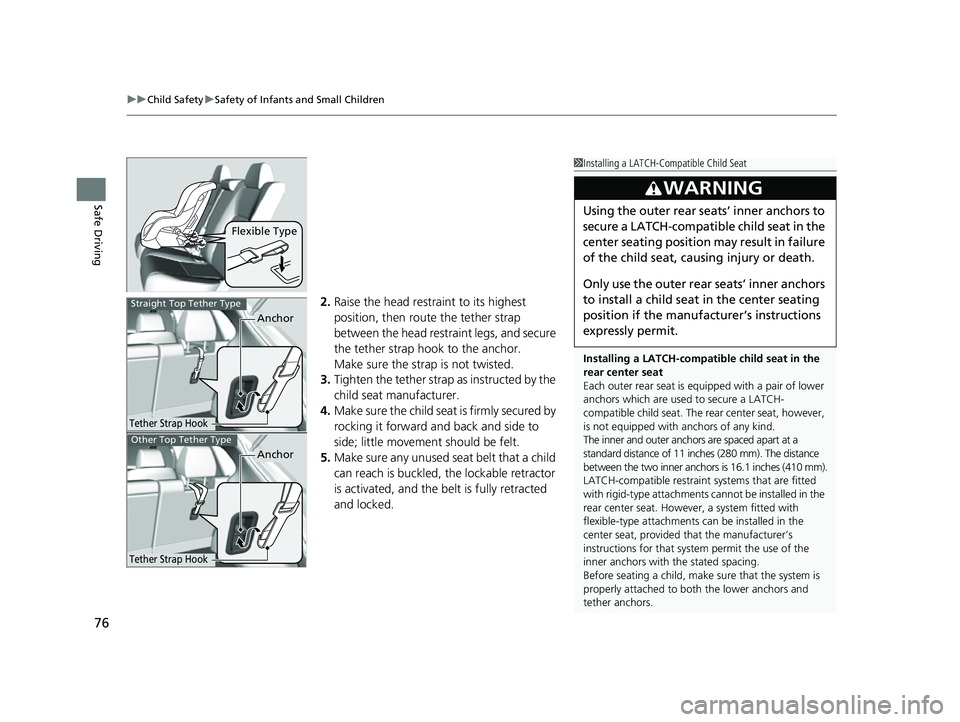
uuChild Safety uSafety of Infants and Small Children
76
Safe Driving
2. Raise the head restraint to its highest
position, then rout e the tether strap
between the head restraint legs, and secure
the tether strap hook to the anchor.
Make sure the strap is not twisted.
3. Tighten the tether strap as instructed by the
child seat manufacturer.
4. Make sure the child seat is firmly secured by
rocking it forward and back and side to
side; little movement should be felt.
5. Make sure any unused seat belt that a child
can reach is buckled, the lockable retractor
is activated, and the be lt is fully retracted
and locked.
Flexible Type
1 Installing a LATCH-Compatible Child Seat
Installing a LATCH-compatible child seat in the
rear center seat
Each outer rear seat is equi pped with a pair of lower
anchors which are used to secure a LATCH-
compatible child seat. The rear center seat, however,
is not equipped with anchors of any kind.
The inner and outer anchors are spaced apart at a
standard distance of 11 in ches (280 mm). The distance
between the two inner anchors is 16.1 inches (410 mm).
LATCH-compatible restraint systems that are fitted
with rigid-type attachments cannot be installed in the
rear center seat. However, a system fitted with
flexible-type attachments can be installed in the
center seat, provided that the manufacturer’s
instructions for that system permit the use of the
inner anchors with the stated spacing.
Before seating a child, make sure that the system is
properly attached to both the lower anchors and
tether anchors.
3WARNING
Using the outer rear seats’ inner anchors to
secure a LATCH-compatible child seat in the
center seating position may result in failure
of the child seat, causing injury or death.
Only use the outer rear seats’ inner anchors
to install a child seat in the center seating
position if the manufa cturer’s instructions
expressly permit.
Anchor
Tether Strap Hook
Straight Top Tether Type
Anchor
Tether Strap Hook
Other Top Tether Type
23 HR-V-313V06000_01.book 76 ページ 2022年4月4日 月曜日 午前10時49分
Page 81 of 664
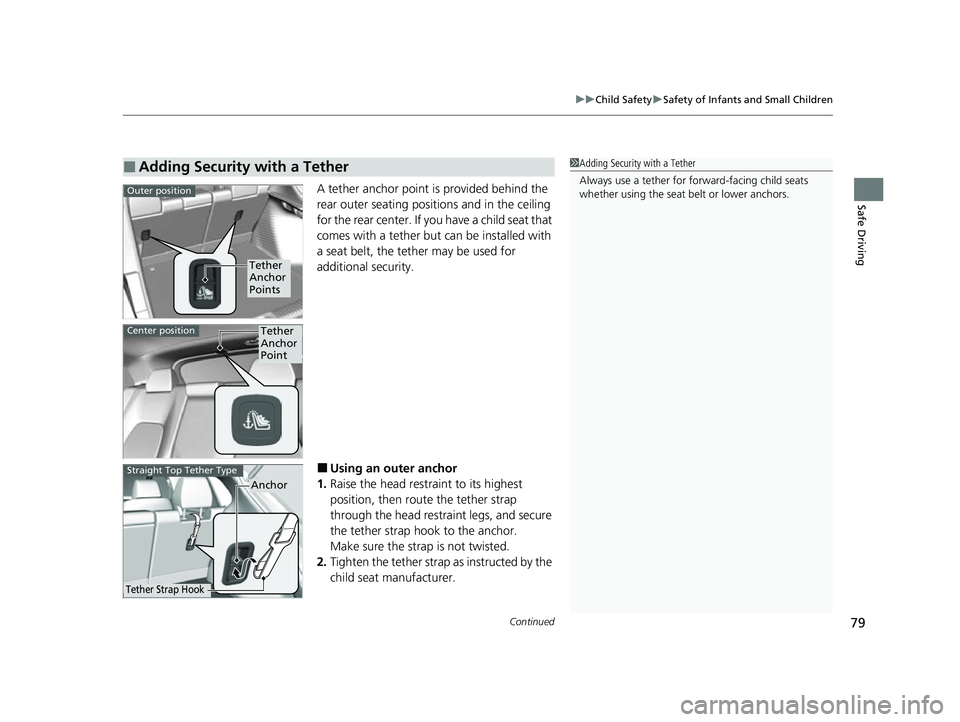
Continued79
uuChild Safety uSafety of Infants and Small Children
Safe DrivingA tether anchor point is provided behind the
rear outer seating positions and in the ceiling
for the rear center. If you have a child seat that
comes with a tether but can be installed with
a seat belt, the tether may be used for
additional security.
■Using an outer anchor
1. Raise the head restraint to its highest
position, then route the tether strap
through the head restraint legs, and secure
the tether strap hook to the anchor.
Make sure the strap is not twisted.
2. Tighten the tether strap as instructed by the
child seat manufacturer.
■Adding Security with a Tether1Adding Security with a Tether
Always use a tether for forward-facing child seats
whether using the seat belt or lower anchors.
Tether
Anchor
Points
Outer position
Tether
Anchor
PointCenter position
Anchor
Tether Strap Hook
Straight Top Tether Type
23 HR-V-313V06000_01.book 79 ページ 2022年4月4日 月曜日 午前10時49分
Page 82 of 664
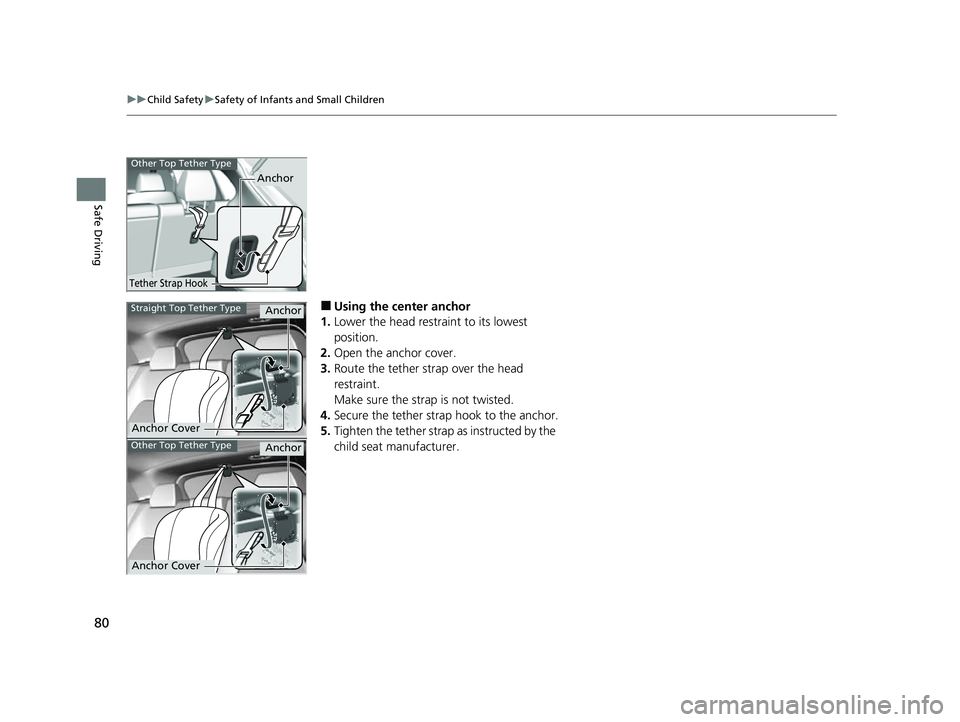
80
uuChild Safety uSafety of Infants and Small Children
Safe Driving
■Using the center anchor
1. Lower the head restra int to its lowest
position.
2. Open the anchor cover.
3. Route the tether strap over the head
restraint.
Make sure the strap is not twisted.
4. Secure the tether strap hook to the anchor.
5. Tighten the tether strap as instructed by the
child seat manufacturer.
Anchor
Tether Strap Hook
Other Top Tether Type
Anchor
Anchor Cover
Straight Top Tether Type
Anchor
Anchor Cover
Other Top Tether Type
23 HR-V-313V06000_01.book 80 ページ 2022年4月4日 月曜日 午前10時49分